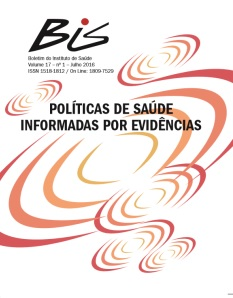Abstract
Brazil is still far from achieving the Millennium Development Goals undertaken in 1990 to reduce maternal mortality (MM). Currently, in the country about 69 women die per 100 thousand live births, but by the goals of the United Nations, that number should be a maximum of 35 women. In this context, it is possible to emphasize that the main causes of these deaths are hypertension, hemorrhage, complications of abortion in unsafe conditions and postpartum infections. Moreover, we note high rates of MM in Brazil in remote areas, where access to health networks is almost non-existent and / or precarious. In the city of Franco da Rocha, the high MM rates have been worrying policy makers, especially because it is related to causes considered preventable. This article presents some of the results of a Policy Brief prepared by students of the Professional Program in Public Health at Instituto de Saúde, with the support of its Evidence Center, which is part of the Evidence Informed-Policy Network - EVIPNet Brazil in order to support municipal policy makers in Franco da Rocha in decision making for reducing MM.
References
BMJ.2004;329(7475):1184.
2. Coimbra CL, Silva AMA, Mochel EG, Alves MTSSB, Ribeiro VS, Aragão VMF, et al. Fatores associados à inadequação do uso da assistência pré-natal.
Rev Saúde Pública. 2003;37:456-62.
3. Fournier P, Dumont A, Tourigny C, Dunkley G, Dramé S. Improved access to comprehensive emergency obstetric care and its effect on institutional
maternal mortality in rural Mali. Bull World Health Organ. 2009;87:30–38.
4. Goldie SJ, Sweet S, Carvalho N, Natchu UCM, Hu D. Alternative strategies to reduce maternal mortality in India: a cost-effectiveness analysis. PLoS
Med. 2010;7(4):e1000264.
5. Ivers N, Jamtvedt G, Flottorp S, Young JM, Odgaard-Jensen J, French SD, et al. Audit and feedback: effects on professional practice and health care
outcomes. The Cochrane Database of Systematic Reviews, 3, 2003.
6. Johnston G, Crombie IK, Davies HTO, Millard A. Reviewing audit: barriers and facilitating factors for effective clinical audit. Qual Health Care.
2000;9(1):23–36.
7. Jonas, E. Improving provider performance: an exploration of the literature, Box 3. Bolivia In-Service Training. Mother Care Matters.2000;9:10–1.
8. Kroeger M, Kaphagawani N, Kafulafula UK, Maluwa VM. Final evaluation of the malawi safe motherhood project life saving skills training
programme. Blantyre: DFID/Safe Motherhood Project. 2003.
9. McDermott J, Beck D, Buffington ST, Annas J, Supratikto G, Prenggono D, et al. Two models of in-service training to improve midwifery skills: how
well do they work? J Midwifery Womens Health. 2001;46:217–25.
10. Merkur S, Mladovsky P, Mossialos E, Mckee M. Policy brief. Do lifelong learning and revalidation ensure that physicians are fit to practise?
Copenhagen: WHO; 2008.
11. Ministère de la Santé Publique et de la Population. Normes et procédures cliniques des services de santé de la reproduction en République
Centrafricaine. Haiti; 2003. 84p.
12. Nyamtema AS, Urassa DP, Roosmalen JV. Maternal health interventions in resource limited countries: a systematic review of packages, impacts
and factors for change. BMC Pregnancy and Childbirth. 2011; 11:30.
13. O’rourke K. The effect of hospital staff training on management of obstetrical patients referred by traditional birth attendants. Int J Gynaecol
Obstet.1995;48(Suppl):S95-102.
14. Pattinson R, Kerber K, Waiswa P, Day LT, Mussell F, Asiruddin SK, et al. Perinatal mortality audit: counting, accountability, and overcoming
challenges in scaling up in low-and-middle-income countries. International Jornal of Gynaecology and Obstetrics.2009;107:113–21,121–2.
15. Pattinson RC, Say L, Makin JD, Bastos MH. Auditoría de acontecimientos críticos y retroalimentación (“feedback”) para disminuir la mortalidad y la
morbilidad perinatales y maternas (Revisión Cochrane traducida). Biblioteca Cochrane Plus. 2008;4.
16. Paxton A, Maine D, Freedman L, Fry D, Lobis S. The evidence for emergency obstetric care International Journal of Gynecology and Obstetrics.
2005; 88:181-193.
17. Prost A, Seward N, Azad K, Coomarasamy A, Copas A, Houweling TAJ, et al. Women’s groups practising participatory learning and action to
improve maternal and newborn health in low-resource settings: a systematic review and meta-analysis. Lancet.2013;381:1736–46.
18. Ronsmans C, Vanneste A, Chakraborty J, Van Ginneken J. Decline in maternal mortality in Matlab, Bangladesh: acautionary tale.
Lancet.1997;350:1810-4.
19. Sepou A, Serdouma E, Komas NP, Gody C, Abeye J, Koffi B, et al. Strategies for reducing maternal mortality in Central African Republic. Evidence-
Informed Policy Network (EVIPNet);2011.
20. Shea JB, Grimshaw JM, Wells GA, Boers M, Andersson N,Hamel C, et al. Development of AMSTAR: a measurement tool to assess the methodological
quality of systematic reviews. BMC Medical Research Methodology, London. 2007;7:10.
21. Sloan NL, Nguyen TN, Do TH, Quimby C, Winikoff B, Fassihian G. Effectiveness of lifesaving skills training and improving institutional emergency
obstetric care readiness in Lam Dong, Vietnam. J Midwifery Womens Health. 2005;50:315–2.
22. Thairu A, Schmidt K. Training and author is ingmid level providers in life saving skills in Kenya case study No 8. In: Crump S, editor. Shaping policy
for maternal and newborn health: a compendium of case studies. Baltimore, MD: JHPIEGO.2003.
23. Warren C, Liambila W. Safe motherhood demonstration project western province. approaches to providing quality maternal care in
Kenya. Nairobi: Population Council. 2004.
24. World Health Organization. Monitoring emergency obstetric care: a handbook. Geneva; 2009.
25. World Health Organization. Trends in maternal mortality: 1990 to 2008. Estimates developed by WHO, UNICEF, UNFPA and The World Bank.
Geneva; 2010. [acesso em 13 jun. 2015]. Disponível em: http://whqlibdoc.who.int/ publications/2010/9789241500265_eng.pdf
26. Woods DL. An innovative programme for training in maternal and newborn care. Seminars in Fetal & Neonatal. 1999;4(3):209-216.
27. Van Lonkhuijzen L, Dijkman A, Van Roosmalen J, Zeeman G, Scherpbier A. A systematic review of the effectiveness of training in emergency
obstetric care in low-resource environments. BJOG. 2010; 117(7):777-87.

This work is licensed under a Creative Commons Attribution 4.0 International License.
Copyright (c) 2016 Carolina Médici de Figueiredo, Inayá da Silva Duarte, Luciana C. Alves do Santos, Luciana de Mendonça Freire, Tatiane Aparecida Rocha Marcelo, Sonia Isoyama Venancio
